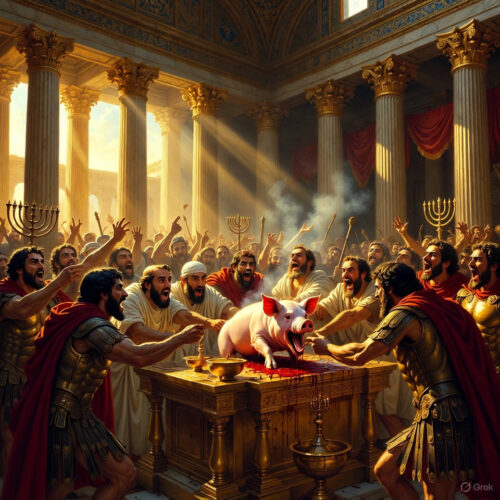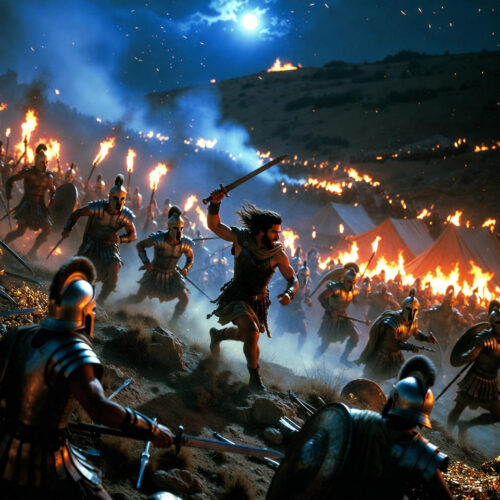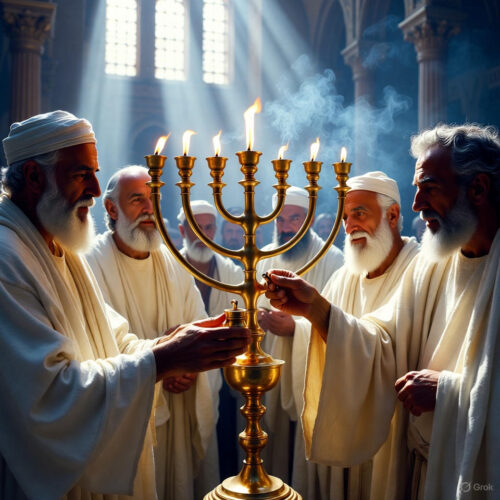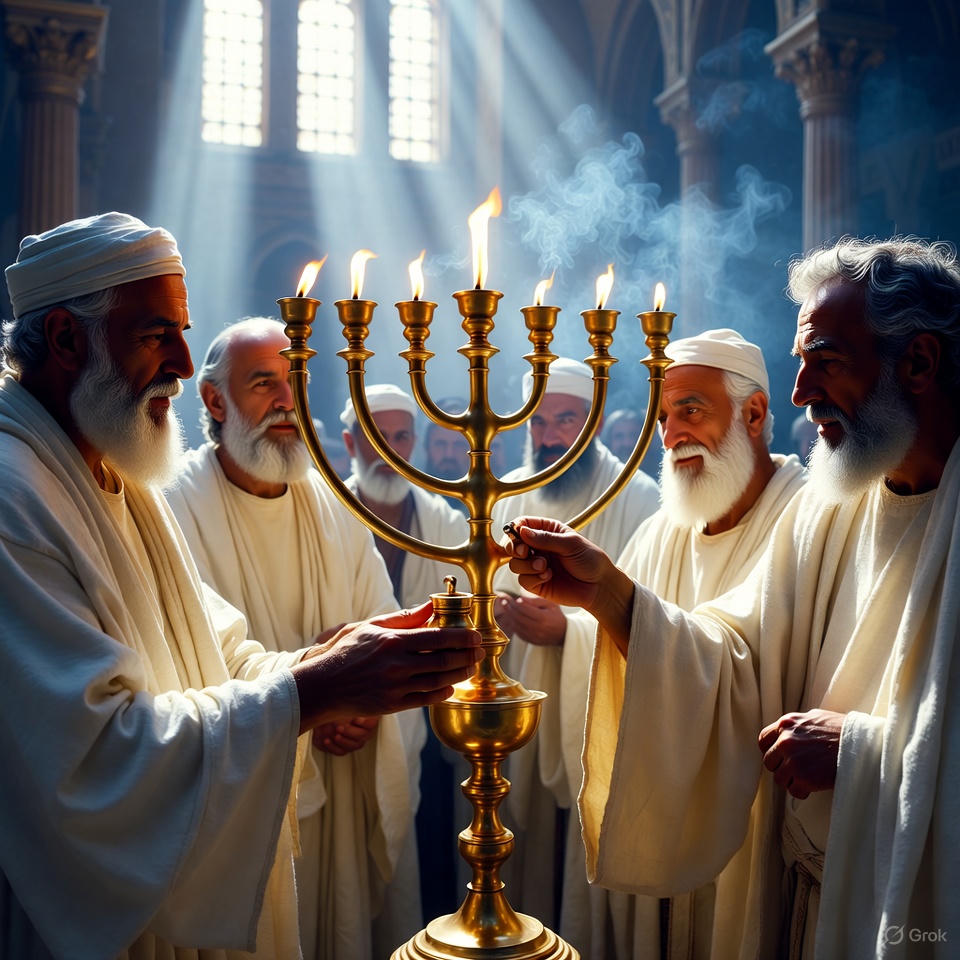Imagine a world where your core beliefs are not just challenged but outright banned, where the symbols of your identity are desecrated, and where standing up could mean death. On November 21, 164 BC, Judas Maccabeus and his band of Jewish rebels turned such oppression into a legendary victory by recapturing Jerusalem from the mighty Seleucid Empire. This wasn’t just a military win; it was a beacon of resilience that birthed Hanukkah and reshaped Jewish history. Research suggests this event marked a pivotal shift toward religious freedom, though debates linger on whether it was purely a holy war or intertwined with political ambitions. It seems likely that the revolt’s success stemmed from guerrilla tactics and internal Seleucid weaknesses, highlighting how underdogs can prevail against empires.
#### The Spark of Rebellion
The Maccabean Revolt didn’t erupt overnight. It was fueled by years of cultural clashes in the ancient Near East, where Hellenistic influences from Alexander the Great’s conquests clashed with Jewish traditions. After Alexander’s death in 323 BC, his empire splintered, and Judea became a battleground between the Ptolemaic Kingdom in Egypt and the Seleucid Empire in Syria. By 198 BC, the Seleucids under Antiochus III had seized control of Judea, initially allowing Jews some autonomy. But his son, Antiochus IV Epiphanes, who ruled from 175 BC, had grander plans. Desperate for funds after a humiliating defeat by Rome and the loss of eastern territories, he turned to plundering temples—including Jerusalem’s—and enforcing Hellenization to unify his crumbling empire.
Antiochus IV, often portrayed as a megalomaniac who called himself “Epiphanes” (meaning “God Manifest”), saw Judaism’s monotheism as a threat to his vision of a Greek-centric world. He replaced the high priest Onias III with Jason, a Hellenized Jew who paid a hefty bribe and promised to transform Jerusalem into a Greek polis complete with a gymnasium. This wasn’t just about sports; the gymnasium symbolized cultural assimilation, where young Jews exercised naked, sometimes even undergoing painful surgeries to reverse circumcision to blend in. When Jason was ousted by another bidder, Menelaus, chaos ensued. Antiochus interpreted Jewish infighting as rebellion during his Egyptian campaigns in 169-168 BC. He stormed Jerusalem, slaughtered thousands, enslaved women and children, and looted the Temple’s treasures, including the golden altar and menorah.
But the worst came in 167 BC. Antiochus outlawed Jewish practices: no more Sabbath observance, no circumcision, no kosher laws. He mandated sacrifices to Greek gods, turning the Second Temple into a shrine for Zeus Olympios. Pigs—unclean animals—were slaughtered on the altar, a deliberate desecration. Inspectors roamed villages, forcing Jews to eat pork or face execution. Many complied out of fear, but others fled to the hills or secretly practiced their faith. This “abomination of desolation,” as described in the Book of Daniel (likely written during the revolt), ignited widespread outrage.
#### The Rise of the Hasmoneans
Enter Mattathias, a priest from the rural village of Modiin, about 17 miles northwest of Jerusalem. From the Hasmonean family (named after an ancestor, Hashmon), Mattathias was no warrior but a devout man in his old age. In 167 BC, a Seleucid officer arrived in Modiin with an altar, demanding a sacrifice to the Greek gods. When a fellow Jew stepped forward to comply, Mattathias snapped. He killed the apostate Jew and the officer, demolished the altar, and cried out, “Let everyone who is zealous for the law and who stands by the covenant follow me!” His five sons—John, Simon, Judas, Eleazar, and Jonathan—joined him, along with their families. They fled to the Judean wilderness, marking the revolt’s humble beginning.
Mattathias organized small raids, tearing down pagan altars, circumcising boys forcibly if needed, and rallying pious Jews known as Hasidim (“pious ones”). He died naturally in 166 BC, passing leadership to his third son, Judas, nicknamed “Maccabeus” or “the Hammer” for his fierce combat style. Judas transformed the ragtag group into a guerrilla force, using hit-and-run tactics in the rugged hills. They avoided open battles, striking at night and melting away. Antiochus, preoccupied with eastern campaigns, dismissed the uprising as minor, sending small detachments under generals like Apollonius.
The first major clash was the Battle of the Ascent of Lebonah in 167 BC, where Judas ambushed a Seleucid patrol, killing many. In 166 BC, at Beth Horon, a narrow pass northwest of Jerusalem, Judas’s 1,000 men routed a larger force led by Seron, using the terrain to cause panic. These early wins boosted morale and recruits. By 165 BC, Antiochus left for Persia to quell rebellions, delegating the Judean issue to his regent Lysias.
#### Escalating Conflicts and Guerrilla Mastery
Judas’s strategy was brilliant: divide forces into small units for mobility, use scouts for intelligence, and pray for divine aid before attacks. The rebels armed themselves with captured weapons—swords, spears, and bows—since they lacked heavy armor or cavalry. In 165 BC, Lysias sent Gorgias with 5,000 infantry and 1,000 cavalry to Gophna. Gorgias planned a night raid on Judas’s camp at Emmaus, but Judas, tipped off by scouts, evacuated and counter-attacked the unguarded Seleucid camp, burning it and routing the troops. When Gorgias returned, he found his base in flames and fled.
Emboldened, Judas marched south to Beth Zur, a fortified town guarding the road to Jerusalem. There, in late 165 BC, he defeated Lysias’s 20,000-strong army in a surprise assault, forcing Lysias to retreat. With the path clear, Judas turned to Jerusalem. The city was in shambles: walls breached, population decimated, and the Acra citadel held by Hellenistic Jews and Seleucids. On November 21, 164 BC, Judas’s forces stormed in, overwhelming the defenders in street fighting. They secured the Temple Mount, though the Acra remained occupied.
The sight inside the Temple horrified them: weeds overgrown, altars to foreign gods, statues of Zeus. Judas selected pure priests to cleanse it, demolishing the polluted altar and building a new one from unhewn stones. They restored the holy vessels, hung new curtains, and relit the eternal flame. On December 25, 164 BC—exactly three years after the desecration—they rededicated the Temple with sacrifices, songs, and an eight-day festival. Legend says a single vial of oil lasted eight days, birthing Hanukkah’s miracle of lights. Antiochus IV died in Persia around this time, possibly from illness, weakening Seleucid resolve. His son, Antiochus V, under Lysias, granted religious freedom but kept political control.
But the fight continued. In 163 BC, Judas besieged the Acra but lifted it to rescue Jews in Galilee and Gilead from persecution. He evacuated thousands in daring operations, defeating Ammonites and others. Back in Judea, at Beth Zechariah in 162 BC, Eleazar died heroically stabbing a war elephant, thinking it carried the king—only to be crushed. Judas lost that battle, retreating to Jerusalem. Lysias besieged the Temple but, facing threats from rival Philip, signed a truce restoring Jewish laws.
#### The Path to Independence
Peace was short-lived. Demetrius I, a Seleucid claimant, seized the throne in 162 BC, executing Antiochus V and Lysias. He appointed Alcimus, a Hellenistic high priest, and sent Bacchides to enforce it. Judas defeated Bacchides at Beth Horon again, but Alcimus returned with Nicanor in 161 BC. At Adasa, Judas crushed Nicanor’s 20,000 men, killing the general—commemorated as Nicanor’s Day. Yet, in 160 BC at Elasa, outnumbered 20:1, Judas charged valiantly but was slain, his body later recovered and buried.
Leadership passed to Jonathan, who negotiated with Demetrius for autonomy. Amid Seleucid civil wars, Jonathan played kings against each other, allying with Alexander Balas in 152 BC to become high priest—a role traditionally Zadokite, sparking controversy. He expanded territory, conquering Joppa and Beth Zur. Captured by Tryphon in 143 BC, Jonathan was executed, but his brother Simon took over. Simon allied with Demetrius II, gaining tax exemption in 142 BC—Judea’s independence day. In 141 BC, he expelled the Acra garrison, purifying Jerusalem fully. Rome and Sparta recognized the Hasmonean state.
Simon was assassinated in 134 BC by his son-in-law, but his son John Hyrcanus solidified the dynasty, ruling until 104 BC. The Hasmoneans blended Jewish and Hellenistic elements, minting coins with Greek inscriptions and hiring mercenaries. They conquered Idumea, Samaria (destroying the Samaritan temple on Mount Gerizim), and Galilee, forcing conversions. Internal strife grew: Pharisees opposed the dual king-priest role, while Sadducees supported it. The dynasty lasted until 37 BC, when Roman-backed Herod ended it.
The revolt’s literature, like 1 and 2 Maccabees (in the Apocrypha), details heroism, while Daniel’s visions reflect apocalyptic hope amid persecution. Rabbinic texts downplay the military aspect, emphasizing the oil miracle to spiritualize Hanukkah.
The Maccabees’ success owed to Seleucid distractions—wars with Parthia, Egypt, and internal usurpers—plus Roman pressure forbidding Syrian expansion. Judas’s tactics inspired later insurgents, from Bar Kokhba to modern guerrillas. Economically, the revolt disrupted trade but fostered self-reliance. Culturally, it preserved Judaism, influencing Christianity (Jesus celebrated Hanukkah in John 10:22-23). Debates persist: was it a civil war between Hellenized and orthodox Jews? Evidence shows most Jews resisted, but elites collaborated.
Zooming out, the revolt fits the Hellenistic era’s tensions, where local traditions clashed with imperial uniformity. Antiochus’s policies echoed Persian tolerance’s reversal, but the Maccabees reversed it through faith-fueled defiance.
#### Lingering Echoes and Broader Impacts
Post-revolt, the Hasmoneans faced challenges. John Hyrcanus’s conquests spread Judaism but bred resentment; Idumeans like Herod later rose. Aristobulus I (104-103 BC) declared himself king, escalating Pharisee opposition. Alexander Jannaeus (103-76 BC) crucified 800 Pharisees, sparking civil war. His widow Salome Alexandra ruled peacefully (76-67 BC), but her sons’ feud invited Roman intervention. Pompey captured Jerusalem in 63 BC, ending independence.
Yet, the revolt’s legacy endures. It symbolized resistance against assimilation, inspiring Zionism and anti-colonial movements. In art, Handel’s oratorio “Judas Maccabeus” celebrates heroism. Archaeologically, sites like Beth Zur yield artifacts confirming battles. Coins from Simon’s era bear Hebrew inscriptions like “Jerusalem the Holy,” affirming sovereignty.
Fun fact: The Maccabees might have used slingshots effectively, as David did against Goliath—poetic justice against Greek giants. And while Hanukkah focuses on lights, ancient texts stress military valor, reminding us history’s layers.
The event’s date, November 21 for the recapture, aligns with historical calendars approximating ancient ones. The rededication followed shortly, solidifying the win.
The Maccabean Revolt stands as one of history’s most audacious uprisings, where a small group of farmers and priests toppled an empire’s grip on their faith and land. Beginning in the shadows of Hellenistic dominance, it unfolded over decades, blending guerrilla warfare, diplomatic maneuvering, and unyielding devotion. Let’s dive deeper into the intricate web of events, figures, and consequences that made this chapter so pivotal.
The backdrop traces to Alexander the Great’s conquest of Persia in 332 BC, when he swept through Judea without resistance, reportedly respecting the high priest. After his death, the Diadochi wars divided his realm: Ptolemies in Egypt tolerated Jewish customs, but Seleucids under Antiochus III conquered Judea in 198 BC at Panium. He issued decrees protecting Temple rights, but fiscal pressures mounted. Antiochus IV’s ascension in 175 BC coincided with Rome’s rising power; humiliated after the Day of Eleusis in 168 BC, where Roman envoy Popillius Laenas drew a circle demanding withdrawal from Egypt, Antiochus vented on Judea.
His Hellenization was systematic: Jason’s gymnasium hosted discus throws and wrestling, eroding Torah study. Menelaus stole Temple funds to pay bribes. The “abomination” in 167 BC involved not just Zeus but possibly Dionysus elements, with prostitutes in sacred precincts per 2 Maccabees. Resistance brewed among Hasidim, precursors to Pharisees and Essenes.
Mattathias’s act in Modiin was catalytic. Aged and fiery, he invoked Phinehas’s zeal from Numbers 25. His family hid in Gophna caves, surviving on herbs to avoid unclean food. Early martyrs included a thousand Jews burned in a cave for refusing Sabbath combat.
Judas, perhaps in his 30s, embodied strategic genius. At Emmaus, he split forces: one flanked while he attacked frontally, capturing tents with gold and silver. Beth Zur’s victory involved blocking passes, starving the garrison. Entering Jerusalem, they mourned like Jacob over Joseph, tearing clothes.
The cleansing took three months; new altar stones followed Exodus 20:25. The eight-day dedication mirrored Sukkot, missed due to war. Antiochus’s death—described in 2 Maccabees as worm-infested agony—was seen as divine retribution.
Post-164 BC, expeditions rescued diaspora Jews: in Gilead, Judas defeated Timotheus, burning foes in a tower. In Galilee, he routed gentiles at Dathema. Beth Zechariah saw 47,000 Seleucids with 32 elephants; Eleazar’s heroism inspired, though futile.
Jonathan’s era shifted to politics. As high priest in 152 BC, he wore the “holy crown.” His capture by Tryphon involved betrayal in Ptolemais. Simon’s independence charter in 142 BC was engraved on bronze tablets on Mount Zion.
Hasmonean expansion: Hyrcanus destroyed Samaria in 108 BC, unearthing Hellenistic artifacts. Jannaeus’s wars reached Transjordan. Salome’s reign saw Pharisee influence, promoting oral law.
Literary impact: 1 Maccabees, in Hebrew then Greek, glorifies battles; 2 Maccabees, epitomized from Jason of Cyrene, adds supernatural elements like angelic horsemen. Daniel 11 prophesies Antiochus’s fall.
Archaeology: Modiin’s ruins show ancient synagogues; Beth Zur digs reveal fortifications. Coins depict cornucopias, symbols of prosperity.
Culturally, the revolt halted full Hellenization but adopted elements like Greek names (Alexander for Jannaeus). It fostered messianic hopes, influencing Qumran scrolls.
In global context, parallels exist with Celtic revolts against Rome or Indian uprisings against Mughals—small groups leveraging imperial overstretch.
Fun anecdotes: Judas’s men used ram’s horns as signals, echoing Joshua at Jericho. The “hammer” nickname might derive from Aramaic “maqqaba.”
The dynasty’s fall: Pompey’s 63 BC siege used Sabbath inaction against Jews, though some fought.
This event’s ripple: Without it, Judaism might have assimilated, altering Abrahamic faiths.
Now, applying this to today: The Maccabees teach that defiance against odds builds character. Research suggests perseverance in adversity boosts mental health, but controversies note overzealousness can divide. It seems likely their story motivates ethical stands.
**Key Lessons for Your Life:**
– **Stand Firm in Beliefs:** Like Mattathias, refuse compromises eroding your values—say no to toxic jobs.
– **Embrace Small Starts:** Guerrilla tactics show incremental actions compound; begin fitness with 10-minute walks.
– **Build Alliances:** Jonathan’s diplomacy reminds networking aids goals; join professional groups.
– **Adapt and Persevere:** Judas’s terrain use teaches flexibility; pivot careers during setbacks.
– **Celebrate Wins:** Hanukkah’s lights symbolize gratitude; journal daily achievements.
**Your Personal Plan:**
- **Identify Your ‘Temple’:** Reflect on core values threatened—spend 15 minutes journaling.
- **Spark Defiance:** Take one small rebellious act, like learning a skill defying doubts.
- **Gather Forces:** Connect with mentors or communities for support.
- **Strategize Battles:** Set goals with tactics, like breaking projects into ambushes.
- **Rededicate Daily:** Establish rituals celebrating progress, like weekly reviews.
- **Expand Horizons:** Once secure, help others, mirroring Hasmonean growth.
- **Sustain Legacy:** Teach lessons to family, ensuring enduring impact.
Embrace your inner Maccabeus—hammer away at obstacles!

